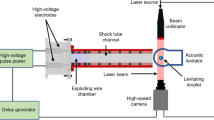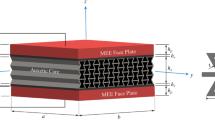Abstract
Shock wave properties of porous specimens made on the basis of matrices composed of inert and chemically active media (silicon rubber and emulsion, which is an aqueous solution of ammonium nitrate with mineral oil and emulsifier) are studied. The porosity of the specimens is generated by using a filler composed of glass microspheres. The wave velocity profiles are measured by a VISAR laser Doppler interferometer. It is shown that the shock compressibility of porous silicon rubber at pressures below 0.1 GPa displays an anomalous behavior, resulting in smearing of the compression pulse front propagating over the specimen. In the emulsion matrices without microspheres, there are no noticeable chemical transformations up to the pressure of 15 GPa. Addition of microspheres drastically decreases the threshold of chemical reaction initiation and leads to the formation of a steady detonation wave.
Similar content being viewed by others
References
A. V. Ostrik and A. I. Potapenko, “Heterogeneous Materials for Protection of Structures from Intense Energy Fluxes,” Konstr. Kompoz. Mat., No. 1, 48–53 (2001).
V. P. Efremov, A. I. Potapenko, and V. E. Fortov, “Mechanical Action of Powerful Energy Fluxes on High-Porosity Materials,” Vopr. Atom. Nauki Ntkh., Ser. Plazm. Elektron. Novye Metody Uskor. 2 (1), 152–154 (2000).
Ya. B. Zel’dovich and Yu. P. Raizer, Physics of Shock Waves and High-Temperature Hydrodynamic Phenomena (Nauka, Moscow, 1966; Academic Press, New York, 1967)
L. D. Landau and E. M. Lifshits, Course of Theoretical Physics, Vol. 6: Fluid Mechanics (Nauka, Moscow, 1986; Pergamon Press, Oxford-Elmsford, New York, 1987).
M. Yoshida, M. Iida, K. Tanaka, et al., “Detonation Behavior of Emulsion Explosives Containing Glass Microballoons,” in Proc. 8th Symp. Int. on Detonation (1985), pp. 171–177.
J. Lee, F. W. Sandstrom, B. G. Graig, and P. A. Persson, “Detonation and Shock Initiation Properties of Emulsion Explosives,” in Proc. 9th Int. Detonation Symp. (1989), pp. 573–584.
V. V. Silvestrov, A. V. Plastinin, S.M. Karakhanov, and V. V. Zykov, “Critical Diameter and Critical Thickness of an Emulsion Explosive,” Fiz. Goreniya Vzryva 44 (3), 121–127 (2008) [Combust., Expl., Shock Waves 44 (3), 354–359 (2008)].
I. M. Voskoboinikov, A. N. Afanasenkov, and V. M. Bogomolov, “Generalized Shock Adiabat of Organic Liquids,” Fiz. Goreniya VZryva 3 (4), 585–593 (1967) [Combust., Expl., Shock Waves 359–364 (1967)].
R. W. Woolfolk, M. Cowperthwaite, and R. Shaw, “A ‘Uuniversal’ Hugoniot for Liquids,” Thermochim. Acta 5 (4), 409–414 (1973).
Physics of Explosion, Ed. by L. P. Orlenko (Fizmatlit, Moscow, 2002), Vol. 1 [in Russian].
G. I. Kanel’, S. V. Razorenov, A. V. Utkin, and V. E. Fortov, Shock Wave Phenomena in Condensed Media (Yanus-K, Moscow, 1996) [in Russian].
Yu. B. Kalmykov, G. I. Kanel’, I. P. Pakhomenko, et al., “Behavior of Rubber in Shock Waves and Unloading Waves,” Prikl. Mekh. Tekh. Fiz. 31 (1), 126–130 (1990) [J. Appl. Mech. Tech. Phys. 31 (1), 116–119 (1990)].
B. R. Gafarov, A. V. Utkin, S. V. Razorenov, et al., “Front Structure of the Weak Shock Wave in Dense Composites,” Prikl. Mekh. Tekh. Fiz. 40 (3), 161–167 (1999) [J. Appl. Mech. Tech. Phys. 40 (3), 501–506 (1999)].
V. V. Budov, “Strength of Hollow Glass Microspheres of Different Types,” Probl. Prochn., No. 5, 68–70 (1991).
V. V. Silvestrov, A. S. Yunoshev, A. V. Plastinin, and S. I. Rafeichik, “Shock Compression of an Emulsion Matrix at Pressures up to 37 GPa,” Fiz. Goreniya Vzryva 50 (4), 110–116 (2014) [Combust., Expl., Shock Waves 50 (4), 470–476 (2014)].
V. V. Silvestrov, A. S. Yunoshev, and A. V. Plastinin, “Hugoniot of an Emulsion Matrix Based on Aqueous Ammonium Nitrate,” Fiz. Goreniya Vzryva 50 (6), 105–108 (2014) [Combust., Expl., Shock Waves 50 (6), 716–719 (2014)].
A. S. Yunoshev, V. V. Silvestrov, A. V. Plastinin, and S. I. Rafeichik, “Influence of Artificial Pores on Detonation Parameters of an Emulsion Explosive,” Fiz. Goreniya Vzryva 53 (2), 91–97 (2017) [Combust., Expl., Shock Waves 53 (2), 205–210 (2017)].
Author information
Authors and Affiliations
Corresponding author
Additional information
Original Russian Text © A.N. Zubareva, A.V. Utkin, V.V. Lavrov.
Published in Fizika Goreniya i Vzryva, Vol. 54, No. 5, pp. 35–44, September–October, 2018.
Rights and permissions
About this article
Cite this article
Zubareva, A.N., Utkin, A.V. & Lavrov, V.V. Shock Wave Properties of Inert and Chemically Active Porous Media. Combust Explos Shock Waves 54, 543–551 (2018). https://doi.org/10.1134/S0010508218050052
Received:
Published:
Issue Date:
DOI: https://doi.org/10.1134/S0010508218050052




